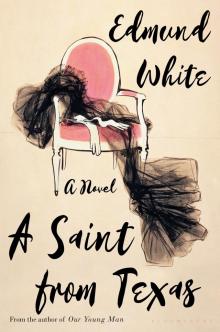- Home
- Edmund White
Inside a Pearl Page 16
Inside a Pearl Read online
Page 16
Then her sister called to say MC was locked up in a clinic.
“Did she try to hurt herself?” I asked.
“Yes,” Thérèse whispered over the line. “Years ago when Laurent threatened to leave her for another woman, she also tried suicide, and he backed down. But this time he is determined to leave, he’s already left. Anne called him to say what MC had done.”
The next thing I knew I was on the train out to the Clinique Médicale de Ville d’Avray, on the rue Picadier in the suburb of Ville-d’Avray. The clinic was old and didn’t seem altogether clean. It smelled horrible. I was shown up to the top floor. The door was unlocked for me, I was ushered in, and then the prison-barred door was locked behind me.
MC was dressed in one of her bright red Japanese robes of crisp silk, and she had on a turban that made her face look like that of a man, a starving man.
I felt sorry for her, and I wondered if she’d ever regain her sanity. I had witnessed something similar with my mother after she’d stopped drinking and was going through the DTs. My mother had had her ecstatic two weeks and then plunged into despair. I’d hospitalized her in a psych ward, but she checked herself out the next morning and hired a car and drove off to a remote hotel in Wisconsin where she stayed for weeks, frantically writing her memoirs, which I promised to publish in a limited edition: Delilah: A Life in Progress. I thought writing would save her life, as I felt it had mine. She followed through and so did I, and she was able to peddle the book to the ladies at her church, although it must have shocked them with its frank accounts of my father’s promiscuity and bouts with gonorrhea. It turned out room service was the best cure for craziness; a handsome young waiter would bring food at your bidding and you could dismiss him whenever you chose. Complete control.
And yet my mother had been a capable woman for decades, administering a clinic for the mentally retarded and brain-damaged at Cook County Hospital in Chicago. Then she’d retired, undergone surgery for breast cancer, and lost her lover of many years (she’d lied about her age and he’d chanced upon her passport). Of course, it had been a shock to see her fall apart, just as now it was devastating to see MC in a lockup cell at a clinic. My mother came for her annual visit and told MC, “Now, Marie-Claude, we’ll see what you’re made of. Will you be strong enough to recover? We’ll see …” MC was offended by her lack of sympathy, but this challenge, or the galvanizing indignity of it, possibly helped mobilize her forces of recovery.
I paid repeated visits to the clinic, with its inmates gabbling to themselves in the day room or sitting in a drug-induced stupor. After a while MC was doing well enough that she was put in an ordinary room with another woman. Eventually she was judged able to go on long walks with me through the Parc de Saint-Cloud. Here there had once been a royal chateau that was destroyed by the Communards in 1870, although the grounds were left intact. Around 1904, Eugène Atget, the great photographer of Paris, had taken dreamy, misty pictures of the grounds and its sculptures. It was that Saint-Cloud we were visiting, MC and I. Steadily, arm in arm, we strolled along the parterres, down two steps, up three, flanked by white marble goddesses and nymphs, everything damp and pearl gray.
I thought of us as the two eighteenth-century ghosts in Verlaine’s “Colloque Sentimentale”:
In the old park, solitary and icy,
Two forms just went by.
Their eyes are dead and their lips slack
And you can scarcely hear their words.
In the old park, solitary and icy,
Two specters have summoned up the past.
One of the ghosts asks his companion if she still sees his soul when she dreams and she replies, “No.” When he tries to remind her that in the beautiful days of the past they joined their lips, she says merely, “It’s possible.”
It wasn’t that I thought MC and I were glued together despite our extinct passion for one another. It was just the idea of two people no longer young tottering arm in arm through an icy old park that struck me. It occurred to me that Europe in general and Paris in particular had been painted and written about so thoroughly that every experience has its correlative in art—whereas American life still goes unmapped. That’s why it sometimes feels so raw. And so challenging to a novelist.
In her suffering MC began to cling to me, literally, sometimes, and I’d come back to the Île Saint-Louis still feeling her iron claws digging into my arm. But she must have seen how I was afraid of her neediness. I wasn’t going to be her new husband, though I was happy to be her new escort and her friend—her brother, possibly, but not her new mate.
Not immediately but very quickly she reset her dials. She found that perfect combination of elements to enable our friendship, the combination other straight women I’d known had failed to adopt. Some heterosexual women acted patronizing to their gays, their “capons,” as we said in America. They’d perk up for a real man, a heterosexual contender, no matter how played out he was. Or they’d want to have “girl talk” with a gay guy about how to trap a man or save a broken nail. Or late at night, after three drinks or ten, they’d become amorous—their kisses opening up full mouth and lingering too long. They’d press their bodies against their poor gay companion’s.
MC avoided all these embarrassments. She’d let me pick up the restaurant check, but she invited me to dinner frequently at her house. She relied on my judgment and even my physical strength for certain jobs around the house in Ré, but she eschewed all hubby-wifey role playing. She was very feminine around me, wanted my approval of her new shoes, and took my arm, but she never presented me with a sexual invitation, or even hint. It was seduction without the sex, intimacy without the boner. I suppose seduction à la française works well because the fiction is that it’s open-ended. No one can say where it will all end—and yet this vagueness about what the future holds is never alarming. I liked going in public with such a stylish woman.
Eventually MC got better. Our walks through the gardens of Saint-Cloud went on longer and longer; the rains never let up, but they were gentle mists, really, as if the landscape were sprayed with an old-fashioned gold-mesh atomizer attached to a cut-glass perfume flask the color of amethyst. As if we were living inside a pearl.
MC’s will—or was it her recklessness?—remained strong. One day she was out of the clinic. She blinked a lot and looked newly hatched, like an aviator who’d been severely burned and only now was freed from her bandages. She looked freshly unwrapped.
Her sister and daughter were on hand to welcome her home. After returning home, MC became more extravagantly feminine, with her Japanese beige scarves lined in black silk and printed with delicate paulownia flowers, her heady honeysuckle perfume, her immaculate red shoes with the black soles and spool heels, her full skirts, and her layered blouses. I thought of those ancient Japanese court women who attracted approval uniquely by the colors of their layered kimono sleeves left to trail from the windows of their litters. While MC became more feminine and espaliered, her female helpers became more male, both clad in dark blue trousers and military shirts, their hair bobbed and their faces scrubbed clean. If MC was their queen bee, they were her drones, patient, attentive, entirely focused on Marie-Claude in all her operatic splendor.
I gave Phyllis Rose, MC’s villain, her sobriquet of La Belle Dame sans Merci, which soon enough was shortened to “La Dame.” Nor did anyone in this household want to hear Babar referred to as anything but the Pachyderm. Laurent became the Pater—in the best Victorian Latinate manner. I caught sight of Phyllis every January in Key West, but MC wouldn’t permit me to socialize with her—very awkward, since Key West is such a small community and Phyllis was at the center of things, and a very nice woman. Eventually, after several years, MC relented.
I thought that what had most wounded MC was losing her status as Madame de Brunhoff. She regretted this more than losing Laurent, though I’m sure she’d loved him. Now she began to see that she was still just as magical to people as she’d been in the past. People appre
ciated MC because of her kindness and her creativity, not her name. She became even kinder and more generous to her friends and even strangers. She said she was imitating my example—kindness, she said, was an American trait.
Laurent came back to Paris on business and MC encouraged me to invite him to lunch, possibly to sound him out. He evidently didn’t like my three-course hot lunch and told me that in America people ate just a sandwich at noon. I was too embarrassed to ask him questions about his “intentions,” but it was obvious that he had none. He was merely passing through town. He was in love with Phyllis.
MC now became practical and bellicose. She felt she had to secure her own rights and protect those of “the children,” Anne and her always strangely absent son, whom I was never permitted to meet—not once in the twenty years of my friendship with MC. I did see him once in the distance, tall and limping in the Bois de Boulogne, but we weren’t introduced. Antoine had had a childhood cancer of the knee, which, when treated with radiation, left the tissue soft and weak. He was married to an older Polish woman and they had an adopted son, Victor. Antoine had trouble earning a living and would do Babar-related odd jobs designing elephant carpets or bedspreads. But his fees were unrealistically high and he was often outbid.
MC’s illness had brought us closer together. I was no longer “the house author,” the way Georges Perec and Julio Cortázar had been before my time (they were dead by the time I came along), but an intimate, a member of the family.
I remembered the memoirs of Virgil Thomson, in which Virgil had been so proud of his friendship with a normal, middle-class French woman—more proud of this than of his artistic collaboration with Gertrude Stein. I suppose it was at this point that I learned that unlike Americans—who claim everyone they know as a friend—the French were quite sparing of who deserved to be called un ami. The French had an entire taxonomy for friendships. There were acquaintances (connaissances) and then buddies (potes) and companions (copains). An acquaintance was addressed as vous except among Communists and among the collegial young or at a gymnasium, where everyone became tu, even if one didn’t know his or her name. A pote would almost certainly be called tu. There was an anti-racist slogan in those years in Paris: Touche-pas à mon pote! (“Keep your hands off my buddy!”).
Among the older bourgeoisie, a copain and even certain amis would be addressed as vous, even as Monsieur or Madame. And only a handful of people at any given moment were ever considered amis—an honorific that carried with it certain duties and privileges.
A true friend could be called on at any time, day or night. He would never bad-mouth his friend—or brag about their link if the friend was well known. Friends could borrow large sums from each other without question. I suppose I learned about French attitudes toward friendship when I wanted to mix members of the press with a few famous friends I’d acquired in Paris at a party for the launching of a book, and Ivan Nabokoff, my editor then as now, let me know that in France you might have a party for your real friends and another for the press but you wouldn’t try to mix the two. Of course, this discretion was foreign to everything I’d learned in New York, where you had to guarantee two or three celebrities to reporters if you expected them to attend your event.
Chapter 11
The party for the translation of my novel A Boy’s Own Story (Un jeune Americain) was being held at Azzedine Alaïa’s new showrooms across from the BHV department store on the rue de la Verrerie, a venue that was already an automatic cause for excitement.
I’d written an article for Vanity Fair about Azzedine and become rather close to him. It was my good luck that I’d been assigned to write about such a genuine artist. He lived with a tall, aristocratic German above the store. His dream was that many of his “girls,” the models he worked with, would live there with him. Azzedine was a tiny Tunisian who told endless stories about the great ladies he’d known. One was the writer Louise de Vilmorin, who’d treated Azzedine as her confidant and court jester. When she was reunited with her American grandson (her first husband had been an American real estate tycoon and they’d lived together in Las Vegas), Louise had asked Azzedine’s advice about which side of her face she should show the boy and what she should be wearing? Where should she be seated?
Greta Garbo was another client. Cecilia Rothschild, who was Garbo’s companion at that time, before the deal was done had said to Azzedine, “I have a very special client for you but you mustn’t make any sort of fuss over her.” Azzedine promised he wouldn’t.
As it turned out, he and his boyfriend had seen Queen Christina at the cinema the night before their encounter with Garbo, so they recognized that sublime face right away. Garbo wanted Azzedine, who at that time was dressmaker for just a few ladies, to make her a military greatcoat. She already had the fabric. He draped it over her and pinned it up. All night long, he experimented with the coat; his German lover, who was tall and thin like Garbo, modeled the coat in their tiny rue de Bellechasse apartment. Then he returned with the perfected coat. Garbo gave him suggestions after each fitting. Azzedine claimed that Garbo’s suggestions had helped purify his taste. “Human taste,” he told me, “was at an all-time low in 1970, when orange and black were the popular colors!”
By the time I knew him, Azzedine Alaïa was working through the night with the young, very young, Naomi Campbell—who he said was like a daughter to him. She would stand on a raised model’s dais as he wrapped and draped her, occasionally sticking her with a straight pin, which would elicit a yelp. There was a full-time chef on hand, who’d cook at midnight a lamb roast with honey and mint leaves sealed in aluminum foil. Or Azzedine would invite everyone to the terrace of the Voltaire, where we’d eat looking out at the ghostly outlines of the Louvre.
He was exactly my age but he seemed full of experience and wisdom. He wanted me to write his biography but was unwilling to pay me the price of even one of his dresses.
He did have wonderful stories. When he was a boy, his grandfather would send him to a local café in Tunisia to reserve a seat for him next to the radio, the only one in the village. When it came time for Umm Kulthum to sing (a performance that was broadcast across the Arab world from Cairo), Azzedine’s grandfather would sit in his reserved chair, place a jasmine sprig behind his ear, and weep at the beautiful words and music. Umm Kulthum was the Maria Callas of the Arab world, and one of the few popular things America ever did for the Arabs occurred when a doctor in Boston operated successfully on a node on her vocal cords. Once in Jordan, as I rode in a taxi all night through the snow from Petra to Assam to catch a plane for England the next morning, the flirty driver and I listened to his tape of her haunting voice while he told me about his unhappy marriage to a Texan whose parents insisted he must be a Mexican since he had a funny accent and was tan.
Azzedine could never manage to show at the same time as the other couturiers, so the big buyers from America would have to make a second trip back to Paris to see his collection.
What were his influences? Aside from Garbo, he was very impressed by Arletty, who in her 1938 film Hotel du Nord had worn a dress that had a zipper on the bias from top to bottom. This dress fascinated him, and years later he was designing similar things. Another influence was Madame Madeleine Vionnet (1876–1975). The Musée de la Mode didn’t know what to do with the boxes of cloth panels it received from the House of Vionnet; it was Azzedine who sorted them out and draped them over the wicker mannequins the museum had decided to use.
Like Vionnet, Azzedine was known as an “architect of the body.” She had used such unusual materials as gabardine panels that clung to each other. In his work, he was called the King of Cling; she had cut her fabrics on the bias so the dresses would move with the body rather than try to mold it or hold it in a predestined shape. She had been influenced by Isadora Duncan and by our modern ideas of ancient Greek clothes—all floating panels of cloth moving with the body. People always said that Azzedine’s clients (Grace Slick, Tina Turner, Madonna) already had great bodies, sl
im and athletic, which only needed to be revealed rather than suppressed and contained. Madame Vionnet’s dresses moved with a similar fluidity, with the body’s natural curves freed of corsets.
Azzedine told me about his visit to the archives of the Fashion Institute of Technology in Manhattan, where the European designers were on the opposite side of the room from the Americans. Azzedine came upon a dress marked as American and said, “You’ve put this on the wrong side.” It was by Charles James, the British couturier who lived in New York and who, like Azzedine, did not bother to keep pace with the seasons. He had designed a dress like Arletty’s with a spiral zipper, but his dresses, unlike Vionnet’s, were very heavy and obviously structured.
Azzedine was interested in a certain mill in Italy that made a synthetic fabric that would stretch in one direction but not in another. He worked with this mill for years, perfecting his specifications in order to get the exact textile properties he wanted.
Everyone in Paris seemed obsessed with fashion, especially women. Some older ladies were content to appear merely neat and clean, but younger women, especially those in daily contact with the public, invested a large part of their yearly income in a single outfit, which they wore every day for a year and which would testify to their status and chic taste. Unlike Americans, who would have a closet stuffed with cheap, ill-fitting dresses, a French woman would have just one or two every season—perfect and way beyond her means. Some went to a cheap fabric market, like the Marché Saint-Pierre below the Sacré-Coeur, bought five-meter bolts, and cut and sewed their own garments that were rip-offs of the latest designs.

 A Saint from Texas
A Saint from Texas The Farewell Symphony
The Farewell Symphony The Married Man
The Married Man A Boy's Own Story
A Boy's Own Story City Boy
City Boy Inside a Pearl
Inside a Pearl Our Young Man
Our Young Man Jack Holmes and His Friend
Jack Holmes and His Friend